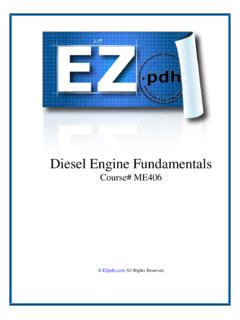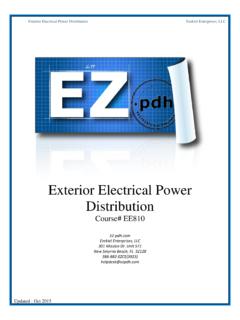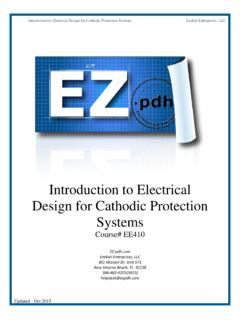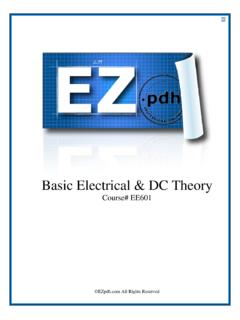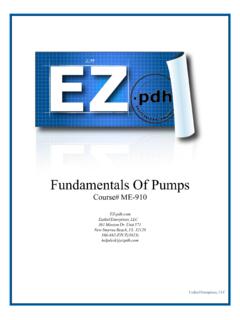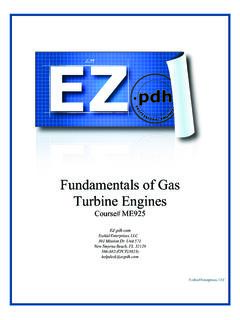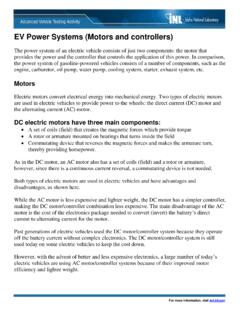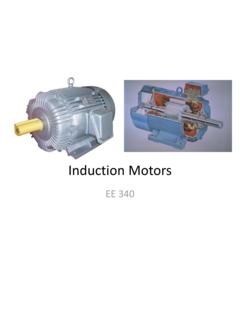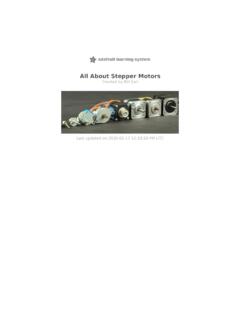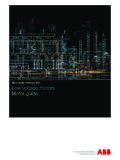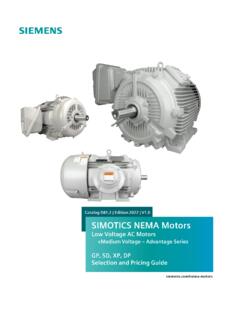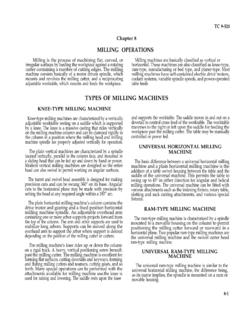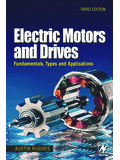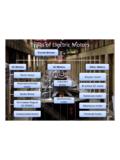Transcription of AC Theory, Circuits, Generators & Motors
1 ac theory , Circuits, Generators & Motors Course# EE603 All Rights Reserved DOE-HDBK-1011/3-92 JUNE 1992 DOE FUNDAMENTALS HANDBOOKELECTRICAL SCIENCEV olume 3 of Department of EnergyFSC-6910 Washington, 20585 Distribution Statement A. Approved for public release; distribution is document has been reproduced directly from the best available to DOE and DOE contractors from the Office of Scientific and TechnicalInformation. P. O. Box 62, Oak Ridge, TN 37831; prices available from (615) to the public from the National Technical Information Service, of Commerce, 5285 Port Royal Rd., Springfield, VA No. DE92019787 ELECTRICAL SCIENCERev. 0 ESABSTRACTThe Electrical Science Fundamentals Handbook was developed to assist nuclear facilityoperating contractors provide operators, maintenance personnel, and the technical staff with thenecessary fundamentals training to ensure a basic understanding of electrical Theory, terminology, and application.
2 The handbook includes information on alternating current (AC)and direct current (DC) theory , circuits, Motors , and Generators ; AC power and reactivecomponents; batteries; AC and DC voltage regulators; transformers; and electrical testinstruments and measuring devices. This information will provide personnel with a foundationfor understanding the basic operation of various types of DOE nuclear facility Words: Training Material, Magnetism, DC theory , DC Circuits, Batteries, DCGenerators, DC Motors , ac theory , AC Power, AC Generators , Voltage Regulators, ACMotors, Transformers, Test Instruments, Electrical DistributionELECTRICAL SCIENCERev. 0 ESFOREWORDThe Department of Energy (DOE) Fundamentals Handbooks consist of ten academicsubjects, which include Mathematics; Classical Physics; Thermodynamics, Heat Transfer, andFluid Flow; Instrumentation and Control; Electrical Science; Material Science; MechanicalScience; Chemistry; Engineering Symbology, Prints, and Drawings; and Nuclear Physics andReactor theory .
3 The handbooks are provided as an aid to DOE nuclear facility handbooks were first published as Reactor Operator Fundamentals Manuals in 1985for use by DOE category A reactors. The subject areas, subject matter content, and level ofdetail of the Reactor Opera tor Fundamentals Manuals were determined from several Category A reactor training managers determined which materials should be included, andserved as a primary reference in the initial development phase. Training guidelines from thecommercial nuclear power industry, results of job and task analyses, and independent input fromcontractors and operations-oriented personnel were all considered and included to some degreein developing the text material and learning DOE Fundamentals Handbooks represent the needs of various DOE nuclear facilities'fundamental training requirements. To increase their applicability to nonreactor nuclearfacilities, the Reactor Operator Fundamentals Manual learning objectives were distributed to theNuclear Facility Training Coordination Program Steering Committee for review and update their reactor-specific content, DOE Category A reactor training managers alsoreviewed and commented on the content.
4 On the basis of feedback from these sources,information that applied to two or more DOE nuclear facilities was considered generic and wasincluded. The final draft of each of the handbooks was then reviewed by these two approach has resulted in revised modular handbooks that contain sufficient detail such thateach facility may adjust the content to fit their specific handbook contains an abstract, a foreword, an overview, learning objectives, andtext material, and is divided into modules so that content and order may be modified byindividual DOE contractors to suit their specific training needs. Each subject area is supportedby a separate examination bank with an answer DOE Fundamentals Handbooks have been prepared for the Assistant Secretary forNuclear Energy, Office of Nuclear Safety Policy and Standards, by the DOE TrainingCoordination Program.
5 This program is managed by EG&G Idaho, SCIENCERev. 0 ESOVERVIEWThe Department of Energy Fundamentals Handbook entitled Electrical Science wasprepared as an information resource for personnel who are responsible for the operation of theDepartment's nuclear facilities. A basic understanding of electricity and electrical systems isnecessary for DOE nuclear facility operators, maintenance personnel, and the technical staff tosafely operate and maintain the facility and facility support systems. The information in thehandbook is presented to provide a foundation for applying engineering concepts to the knowledge will help personnel more fully understand the impact that their actions mayhave on the safe and reliable operation of facility components and Electrical Science handbook consists of fifteen modules that are contained in fourvolumes.
6 The following is a brief description of the information presented in each moduleof the 1 of 4 Module 1 - Basic Electrical TheoryThis module describes basic electrical concepts and introduces electrical 2 - Basic DC TheoryThis module describes the basic concepts of direct current (DC) electrical circuits anddiscusses the associated 2 of 4 Module 3 - DC CircuitsThis module introduces the rules associated with the reactive components ofinductance and capacitance and how they affect DC 4 - BatteriesThis module introduces batteries and describes the types of cells used, circuitarrangements, and associated SCIENCERev. 0 ESModule 5 - DC GeneratorsThis module describes the types of DC Generators and their application in termsof voltage production and load 6 - DC MotorsThis module describes the types of DC Motors and includes discussions of speedcontrol, applications, and load 3 of 4 Module 7 - Basic AC TheoryThis module describes the basic concepts of alternating current (AC)
7 Electrical circuitsand discusses the associated 8 - AC Reactive ComponentsThis module describes inductance and capacitance and their effects on 9 - AC PowerThis module presents power calculations for single-phase and three-phase AC circuitsand includes the power triangle 10 - AC GeneratorsThis module describes the operating characteristics of AC Generators and includesterminology, methods of voltage production, and methods of paralleling ACgeneration 11 - Voltage RegulatorsThis module describes the basic operation and application of voltage 4 of 4 Module 12 - AC MotorsThis module explains the theory of operation of AC Motors and discusses the varioustypes of AC Motors and their SCIENCERev. 0 ESModule 13 - TransformersThis module introduces transformer theory and includes the types of transformers,voltage/current relationships, and 14 - Test Instruments and Measuring DevicesThis module describes electrical measuring and test equipment and includes theparameters measured and the principles of operation of common 15 - Electrical Distribution SystemsThis module describes basic electrical distribution systems and includes characteristicsof system design to ensure personnel and equipment information contained in this handbook is by no means all encompassing.
8 Anattempt to present the entire subject of electrical science would be impractical. However, theElectrical Science handbook does present enough information to provide the reader with afundamental knowledge level sufficient to understand the advanced theoretical concepts presentedin other subject areas, and to better understand basic system and equipment operations. Department of EnergyFundamentals HandbookELECTRICAL SCIENCEM odule 7 Basic AC TheoryBasic AC TheoryTABLE OF CONTENTSTABLE OF CONTENTSLIST OF iiLIST OF vAC 1 Development of a Sine-Wave 3AC GENERATION 4 Effective 4 Phase 7 Voltage 8 Current 9 Frequency 10 Rev.
9 0 Page iES-07 LIST OF FIGURESB asic AC TheoryLIST OF FIGURESF igure 1 Simple AC 1 Figure 2 Developing a Sine-Wave 2 Figure 3 Voltage Sine 4 Figure 4 Effective Value of 6 Figure 5 Phase 7ES-07 Page iiRev. 0 Basic AC TheoryLIST OF TABLESLIST OF TABLESNONERev. 0 Page iiiES-07 REFERENCESB asic AC TheoryREFERENCESG ussow, Milton, Schaum s Outline Series, Basic Electricity, Program for Nuclear Power Plant Personnel, Volume IV, Columbia, MD:General Physics Corporation, Library of Congress Card #A 326517, and Plane, Chemical Principles and Properties,2ndEdition, Program for Nuclear Power Plant Personnel, Volume II, Columbia, MD:General Physics Corporation, Library of Congress Card #A 326517, and Unnewehr, Electromechanics and Electric Machines, John Wiley and Valkenburgh, Nooger, and Neville, Basic Electricity, Vol. 5, Hayden Industrial Marketing Division, The Storage Battery, Lead-Acid Type, TheElectric Storage Battery , Eugene C.
10 , Electric Circuits and Machines,5thEdition, , Carr, Watt, and Summers, American Electricians Handbook,10thEdition, , C. Russel, The Art and Science of Protective Relaying, John Wiley and , Harry, Electricity One - Seven, Revised 2ndEdition, Hayden Book and Schmitt, Understanding Electricity and Electronics,3rdEdition, , Walter, Electrical Instruments and Measurements, ivRev. 0 Basic AC TheoryOBJECTIVESTERMINAL an alternating current (AC) waveform,DESCRIBEthe relationship betweenaverage and RMS values of voltage and current, and the angular velocity within construction and operation of a simple AC development of a sine-wave output in an AC following terms in relation to AC value of an AC current relative to DC a maximum value,CALCULATEthe effective (RMS) and averagevalues of AC a diagram of two sine waves,DESCRIBEthe phase relationshipbetween the two 0 Page vES-07 Basic AC TheoryIntentionally Left BlankES-07 Page viRev.
